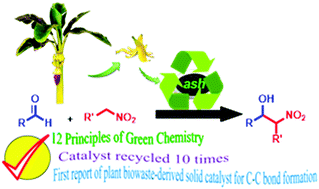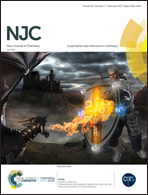Waste-to-useful: a biowaste-derived heterogeneous catalyst for a green and sustainable Henry reaction†
Abstract
Owing to the depletion of resources coupled with increasing waste generation, the conversion of waste biomass to value-added materials has gained interest. Here, we report for the first time the application of Musa acuminata (banana) peel ash (MAPA) as a heterogeneous catalyst for C–C bond formation via a Henry reaction under solvent-free conditions at ambient temperature. The catalyst was well characterized using different analytical techniques like FT-IR, SEM, TEM-EDS, XRD, XRF, XPS, BET and TGA, along with basicity determination by a Hammett indicator test and titration method. An excellent yield of nitroalcohol was obtained within 15–30 minutes. No dehydrated product was observed. The catalyst used in these studies has the advantage of being a waste material and is hence low-cost, easily prepared, recyclable and environmentally friendly. In addition, the use of a biogenic renewable catalyst, its atom economy, and room temperature and solvent-free reaction conditions and the avoidance of column chromatography make the protocol highly significant from green and sustainable chemistry perspectives.



 Please wait while we load your content...
Please wait while we load your content...